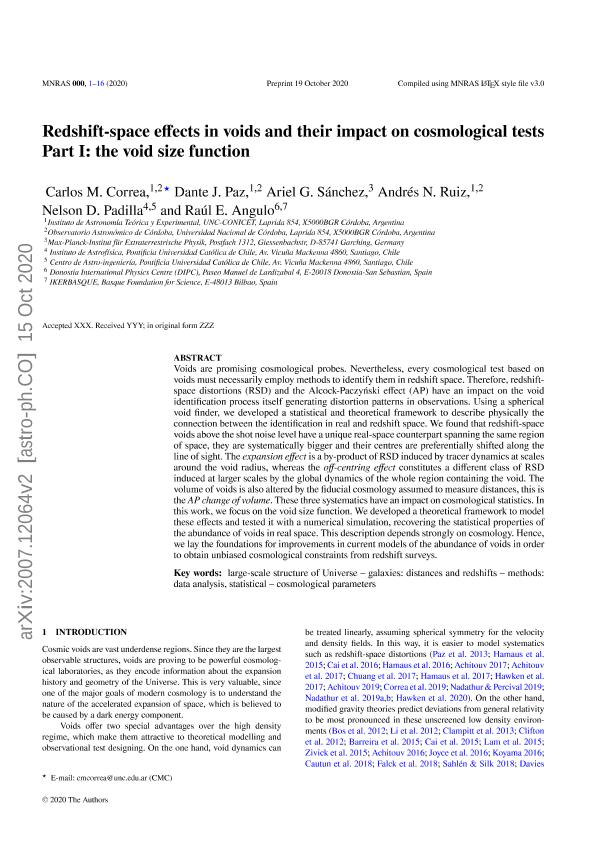Mostrar el registro sencillo del ítem
dc.contributor.author
Correa, Carlos Mauricio

dc.contributor.author
Paz, Dante Javier

dc.contributor.author
Sánchez, Guillermo Ariel

dc.contributor.author
Ruiz, Andrés Nicolás

dc.contributor.author
Padilla, Nelson David

dc.contributor.author
Angulo, Raúl E.
dc.date.available
2021-04-15T11:53:09Z
dc.date.issued
2021-01
dc.identifier.citation
Correa, Carlos Mauricio; Paz, Dante Javier; Sánchez, Guillermo Ariel; Ruiz, Andrés Nicolás; Padilla, Nelson David; et al.; Redshift-space effects in voids and their impact on cosmological tests. Part I: The void size function; Wiley Blackwell Publishing, Inc; Monthly Notices of the Royal Astronomical Society; 500; 1; 1-2021; 911-925
dc.identifier.issn
0035-8711
dc.identifier.uri
http://hdl.handle.net/11336/130088
dc.description.abstract
Voids are promising cosmological probes. Nevertheless, every cosmological test based on voids must necessarily employ methods to identify them in redshift space. Therefore, redshift-space distortions (RSD) and the Alcock-Paczynski effect (AP) have an impact on the void identification process itself generating distortion patterns in observations. Using a spherical void finder, we developed a statistical and theoretical framework to describe physically the connection between the identification in real and redshift space. We found that redshift-space voids above the shot noise level have a unique real-space counterpart spanning the same region of space, they are systematically bigger and their centres are preferentially shifted along the line of sight. The expansion effect is a by-product of RSD induced by tracer dynamics at scales around the void radius, whereas the off-centring effect constitutes a different class of RSD induced at larger scales by the global dynamics of the whole region containing the void. The volume of voids is also altered by the fiducial cosmology assumed to measure distances, this is the AP change of volume. These three systematics have an impact on cosmological statistics. In this work, we focus on the void size function. We developed a theoretical framework to model these effects and tested it with a numerical simulation, recovering the statistical properties of the abundance of voids in real space. This description depends strongly on cosmology. Hence, we lay the foundations for improvements in current models of the abundance of voids in order to obtain unbiased cosmological constraints from redshift surveys.
dc.format
application/pdf
dc.language.iso
eng
dc.publisher
Wiley Blackwell Publishing, Inc

dc.rights
info:eu-repo/semantics/openAccess
dc.rights.uri
https://creativecommons.org/licenses/by-nc-sa/2.5/ar/
dc.subject
COSMOLOGICAL PARAMETERS
dc.subject
GALAXIES: DISTANCES AND REDSHIFTS
dc.subject
LARGE-SCALE STRUCTURE OF UNIVERSE
dc.subject
METHODS: DATA ANALYSIS
dc.subject
METHODS: STATISTICAL
dc.subject.classification
Astronomía

dc.subject.classification
Ciencias Físicas

dc.subject.classification
CIENCIAS NATURALES Y EXACTAS

dc.title
Redshift-space effects in voids and their impact on cosmological tests. Part I: The void size function
dc.type
info:eu-repo/semantics/article
dc.type
info:ar-repo/semantics/artículo
dc.type
info:eu-repo/semantics/publishedVersion
dc.date.updated
2021-03-26T19:35:19Z
dc.identifier.eissn
1365-2966
dc.journal.volume
500
dc.journal.number
1
dc.journal.pagination
911-925
dc.journal.pais
Reino Unido

dc.journal.ciudad
Londres
dc.description.fil
Fil: Correa, Carlos Mauricio. Consejo Nacional de Investigaciones Científicas y Técnicas. Centro Científico Tecnológico Conicet - Córdoba. Instituto de Astronomía Teórica y Experimental. Universidad Nacional de Córdoba. Observatorio Astronómico de Córdoba. Instituto de Astronomía Teórica y Experimental; Argentina
dc.description.fil
Fil: Paz, Dante Javier. Consejo Nacional de Investigaciones Científicas y Técnicas. Centro Científico Tecnológico Conicet - Córdoba. Instituto de Astronomía Teórica y Experimental. Universidad Nacional de Córdoba. Observatorio Astronómico de Córdoba. Instituto de Astronomía Teórica y Experimental; Argentina
dc.description.fil
Fil: Sánchez, Guillermo Ariel. Consejo Nacional de Investigaciones Científicas y Técnicas. Centro Científico Tecnológico Conicet - Córdoba. Instituto de Astronomía Teórica y Experimental. Universidad Nacional de Córdoba. Observatorio Astronómico de Córdoba. Instituto de Astronomía Teórica y Experimental; Argentina. Max-Planck-Institut für Extraterrestrische Physik; Alemania
dc.description.fil
Fil: Ruiz, Andrés Nicolás. Consejo Nacional de Investigaciones Científicas y Técnicas. Centro Científico Tecnológico Conicet - Córdoba. Instituto de Astronomía Teórica y Experimental. Universidad Nacional de Córdoba. Observatorio Astronómico de Córdoba. Instituto de Astronomía Teórica y Experimental; Argentina
dc.description.fil
Fil: Padilla, Nelson David. Pontificia Universidad Católica de Chile; Argentina. Universidad Nacional de Córdoba. Observatorio Astronómico de Córdoba; Argentina
dc.description.fil
Fil: Angulo, Raúl E.. Donostia International Physics Centre; España
dc.journal.title
Monthly Notices of the Royal Astronomical Society

dc.relation.alternativeid
info:eu-repo/semantics/altIdentifier/url/https://academic.oup.com/mnras/advance-article/doi/10.1093/mnras/staa3252/5935248
dc.relation.alternativeid
info:eu-repo/semantics/altIdentifier/doi/https://doi.org/10.1093/mnras/staa3252
Archivos asociados
